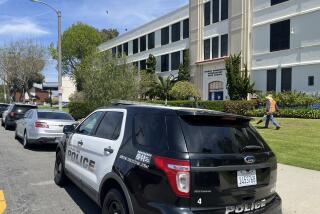Burglars, vandals hit LAUSD 171 times since August, âreprehensibleâ acts against poor schools

Vandals broke into a South Los Angeles elementary school for the sixth time since July over the weekend, causing an estimated $115,000 in damage and adding to a steady toll of recent losses due to theft and vandalism in the L.A. Unified School District.
This semester alone there have been 171 incidents of burglary and vandalism in the nationâs second-largest school system, with Wadsworth Elementary, the site of a Monday news conference, especially hard hit. Districtwide the damage is in the millions of dollars annually, officials said, although they did not release specific figures.
L.A. schools Supt. Alberto Carvalho conceded it was a problem that the school system would typically avoid highlighting.

âWe donât want negative news, right?â Carvalho said. âWe donât necessarily talk about it, but to target, burglarize, vandalize, steal from poor schools â that is reprehensible. So I want to make sure that the community would know about it, and hopefully somebody provides information.â
The damage estimate could rise at Wadsworth once an inventory is completed, which might have to wait for several days because schools have begun their weeklong Thanksgiving break.
The break-in occurred sometime Sunday. Principal Jenny Guzman-Murdock said she had been at the school as recently as Saturday.
Although the campus gets locked up tight, it lacks a burglar alarm, and security cameras have arrived but have not yet been installed. Some schools already have such systems and there are plans to install them at all campuses at significant expense.
The vandals apparently used heavy tools to pry open dead-bolted, metal-reinforced doors â doing major damage to the doors. In all, 24 rooms were broken into, Guzman-Murdock said.
LAUSD board members at Tuesdayâs meeting will consider resolutions on immigration sanctuary, LGBTQ+ protection and accelerating the teaching of current events.
Some staff members showed up to quickly clean up, including community representative Maricela Almaraz, who restored order in the parent center because, she said, she didnât want the parents to see the damage.
No one had yet gotten to a second-floor classroom that was in disarray, with crayons, books and papers dumped on the floor and chairs overturned. Graffiti marred a wall just outside the classroom.
Parent Bertha Cuevas said the vandalism made her angry and apprehensive.
âItâs like the kids are going to have too much trauma in their brains,â said Cuevas, who stood outside the campus with her third-grade son and first-grade daughter. âAnd I donât think thatâs right. I think this school needs to have security cameras on the street, every part of the school.â
Cuevas praised the school for being attentive to children with special needs.

Keeping buildings and property secure is one more challenge added to the school systemâs safety puzzle.
Student activists and some parents have called for eliminating all school police â saying that education dollars should be spent on counselors, mental health and achievement programs instead. In response to such calls, the Board of Education voted in 2020 to slash school police funding by 30%.
But even at its largest, the school police force was never big enough for around-the-clock patrols at some 1,000 campuses in the sprawling district. Instead, Carvalho said, campus security had to be enhanced with a combination of measures.
âI think the solution is one of additional supervision, better community relations, additional information brought to us by members of the community,â he said. âWe have a pretty good idea that these are not outsiders â from outside of the community â coming in. These are individuals who probably live in the community. And weâre hoping that this appeal results in somebody who knows something bringing information to us.â
LAUSD quietly overhauled BSAP, a program meant to bolster struggling Black students, after a legal challenge from a conservative group against basing such help on race.
He called special attention to the districtâs LASAR app, which stands for Los Angeles Schools Anonymous Reporting. Carvalho emphasized that leads reported on LASAR could remain anonymous.
Stolen laptops are clearly marked as L.A. Unified property and can be shut down remotely, he added, making them of little use to thieves. But when they are taken â even when they are later dumped â they still must be replaced at considerable cost, becoming lost educational dollars.
Some incidents appear to be professional jobs âlargely driven by organized crime,â Carvalho said. âSo the stealing of copper, the stealing of catalytic converters. There are adult, criminal entities that organize that, and we want to create community awareness about that as well, which may help âbring those who are responsible to justice.â
Thereâs really no one to monitor security cameras at schools, but they are potentially helpful for deterrence and gathering evidence after the fact. Burglar alarms also are a deterrent.
The school police department â even in its reduced form â has vacant positions. The current strategy is to use officers almost entirely for patrols and emergency situations during school hours.
Los Angeles Unified has been hit by increased crime and violence since students returned to in-person learning after the campus closures of the COVID-19 pandemic.
Even if a large group of pro-police parents prevail in preserving the police department, there currently are not enough officers to patrol campus at the level prior to the reductions. And thereâs only a skeleton crew after hours.
An April report listed 382 police department positions, of which 323 were filled.
Carvalho said he may need to deploy some officers around the clock to sensitive areas, including bus yards, to protect such assets as the catalytic converters on buses.
More to Read
Sign up for Essential California
The most important California stories and recommendations in your inbox every morning.
You may occasionally receive promotional content from the Los Angeles Times.













